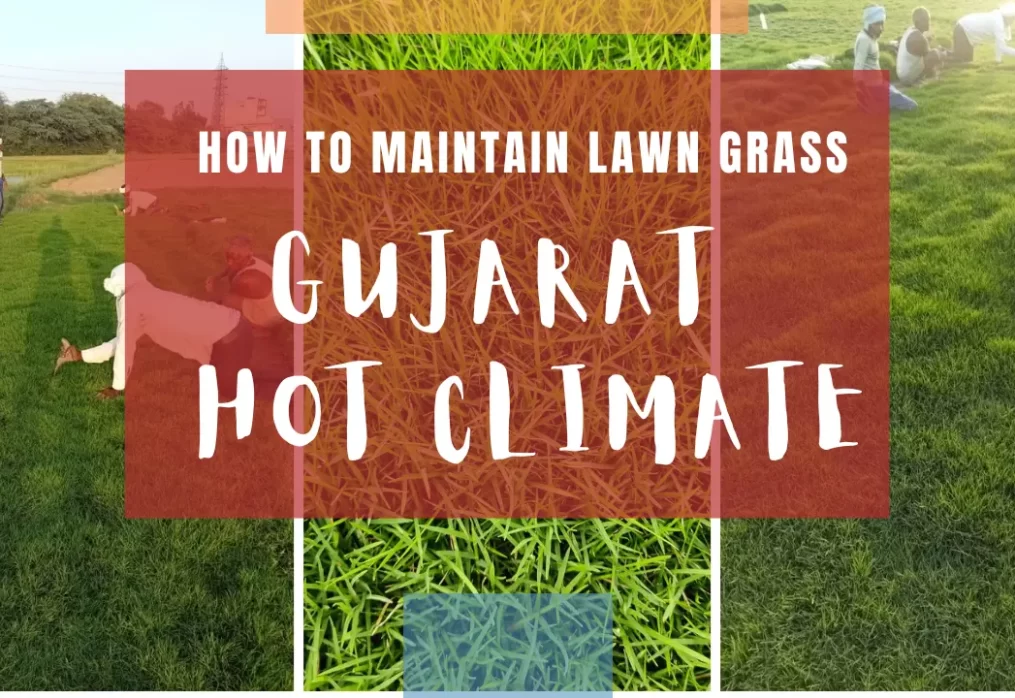How to Maintain Lawn Grass in Gujarat’s Hot Climate
Introduction
Maintaining a lush, green lawn in Gujarat’s hot climate can feel like an uphill battle. With scorching summers, dry winds, and unpredictable rainfall, grass struggles to survive without proper care. Yet, having a healthy lawn isn’t impossible—it just requires the right strategies. Let’s explore how you can keep your lawn thriving even under the blazing Gujarat sun.
Understanding Gujarat’s Climate
Gujarat is known for its extreme summers where temperatures often cross 40°C. The climate is generally arid to semi-arid, with hot winds that dry out the soil quickly. Monsoons bring temporary relief, but excessive rain can cause waterlogging if drainage is poor. This unique weather means grass needs special care to survive and flourish.
Best Grass Types for Gujarat
Not all grasses can withstand Gujarat’s heat. Some hardy varieties include:
-
Bermuda Grass – Extremely drought-tolerant, grows quickly, and stays green most of the year.
-
Doob Grass (Indian Grass) – Native, resilient, and perfect for low-maintenance lawns.
-
Mexican Grass – Soft texture, good for shaded areas, but requires regular care.
-
Zoysia Grass – Dense growth, resists weeds, and tolerates both sun and partial shade.
Tip: Choose grass based on your lawn’s sun exposure and water availability.
Not sure where to purchase high-quality grass suited for Gujarat? Balaji Nursery offers a wide variety of natural lawn grass—such as doob, Mexican, and Bermuda—that thrive in this region. They’re recognized across Ahmedabad and beyond for freshness and reliable delivery.
Soil Preparation for Gujarat Lawns
Healthy soil is the backbone of a thriving lawn.
-
Test your soil for pH levels (ideal is 6.0–7.0).
-
Mix organic compost or cow dung manure to enrich nutrients.
-
Ensure proper drainage to prevent waterlogging during monsoon.
Watering Strategies in Hot Weather
Watering is the trickiest part in Gujarat’s heat.
-
Best time: Early morning before sunrise or late evening.
-
Frequency: Water deeply 2–3 times a week instead of daily light watering.
-
Avoid overwatering, which can invite fungal diseases.
Think of watering like feeding your lawn—too little, it starves; too much, it drowns.
Fertilization Needs
Your grass needs food to stay green.
-
Use organic fertilizers (vermicompost, neem cake, cow dung).
-
Apply balanced NPK fertilizer every 6–8 weeks.
-
Micronutrients like magnesium and iron help prevent yellowing.
Mowing Practices
Improper mowing can kill your lawn faster than heat.
-
Keep the grass at 2–3 inches height during summers to protect roots.
-
Never cut more than one-third of the blade at once.
-
Sharpen mower blades to avoid tearing the grass.
Mulching for Moisture Retention
Mulching acts like sunscreen for your lawn.
-
Apply a thin layer of grass clippings or straw to lock moisture.
-
It prevents weeds and reduces water evaporation.
Weed Control
Weeds steal nutrients and water from your grass.
-
Common weeds: Parthenium, Crabgrass, Nutgrass.
-
Hand-pull weeds regularly or use natural herbicides like vinegar spray.
-
Prevent weeds by keeping your lawn dense and healthy.
Pest and Disease Management
Heat and humidity invite pests.
-
White grubs, armyworms, and termites are common in Gujarat lawns.
-
Look for brown patches—these often mean fungal disease.
-
Use neem oil spray or eco-friendly pesticides for safe control.
Aeration and Lawn Health
In compacted soil, grass roots suffocate.
-
Aerate your lawn once or twice a year.
-
Best time in Gujarat: pre-summer (Feb–March) or post-monsoon (Sept–Oct).
-
Use a simple garden fork or aeration tool.
Seasonal Lawn Care Tips
-
Summer: Deep watering, mulching, mowing high.
-
Monsoon: Watch out for waterlogging and fungal infections.
-
Winter: Reduce watering, mow slightly shorter, fertilize lightly.
Common Mistakes to Avoid
-
Overwatering leads to fungal problems.
-
Excess fertilizer burns grass in high heat.
-
Ignoring soil health makes grass weak and patchy.

Professional Lawn Care Services
If maintaining your lawn feels overwhelming, professional services can help.
-
They provide soil testing, grass selection, irrigation systems, and pest control.
-
Experts save you time while ensuring a picture-perfect lawn.
Conclusion
Maintaining lawn grass in Gujarat’s hot climate may seem tough, but with the right grass type, proper watering, soil care, and seasonal adjustments, your lawn can stay lush and green all year. Remember, a healthy lawn not only beautifies your home but also cools your surroundings naturally—something we all need in Gujarat’s scorching heat.
FAQs
1. How often should I water my lawn in Gujarat?
Water deeply 2–3 times a week, preferably early morning or late evening.
2. Which is the best grass for Gujarat’s hot climate?
Bermuda and Doob Grass are the most heat-tolerant options.
3. Can I grow lawn grass without shade in Gujarat?
Yes, Bermuda and Zoysia thrive in full sun, but Mexican grass prefers partial shade.
4. How do I prevent grass from turning brown?
Ensure proper watering, fertilization, and avoid cutting grass too short.
5. What is the best fertilizer for Gujarat lawns?
Organic compost or a balanced NPK mix with added micronutrients works best.
Last Updated on 3 months ago by Anjali Mehra Ph.D. in Horticulture (Punjab Agricultural University)
- How to Keep Your Gurgaon Lawn Green During Winters - November 15, 2025
- Fast-Growing Grass Types for Farms and Villas in Punjab - November 13, 2025
- Bermuda Grass vs Selection No.1 Grass — Gurgaon Buyers’ Guide - November 10, 2025
